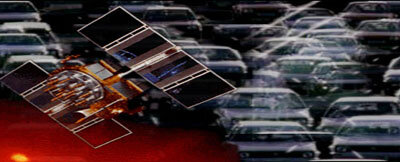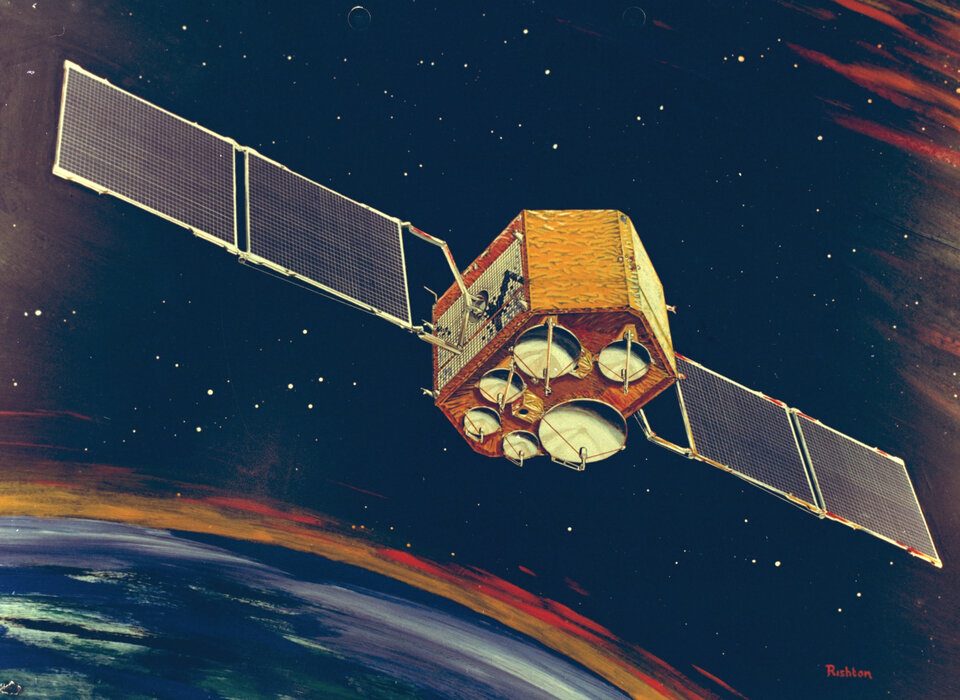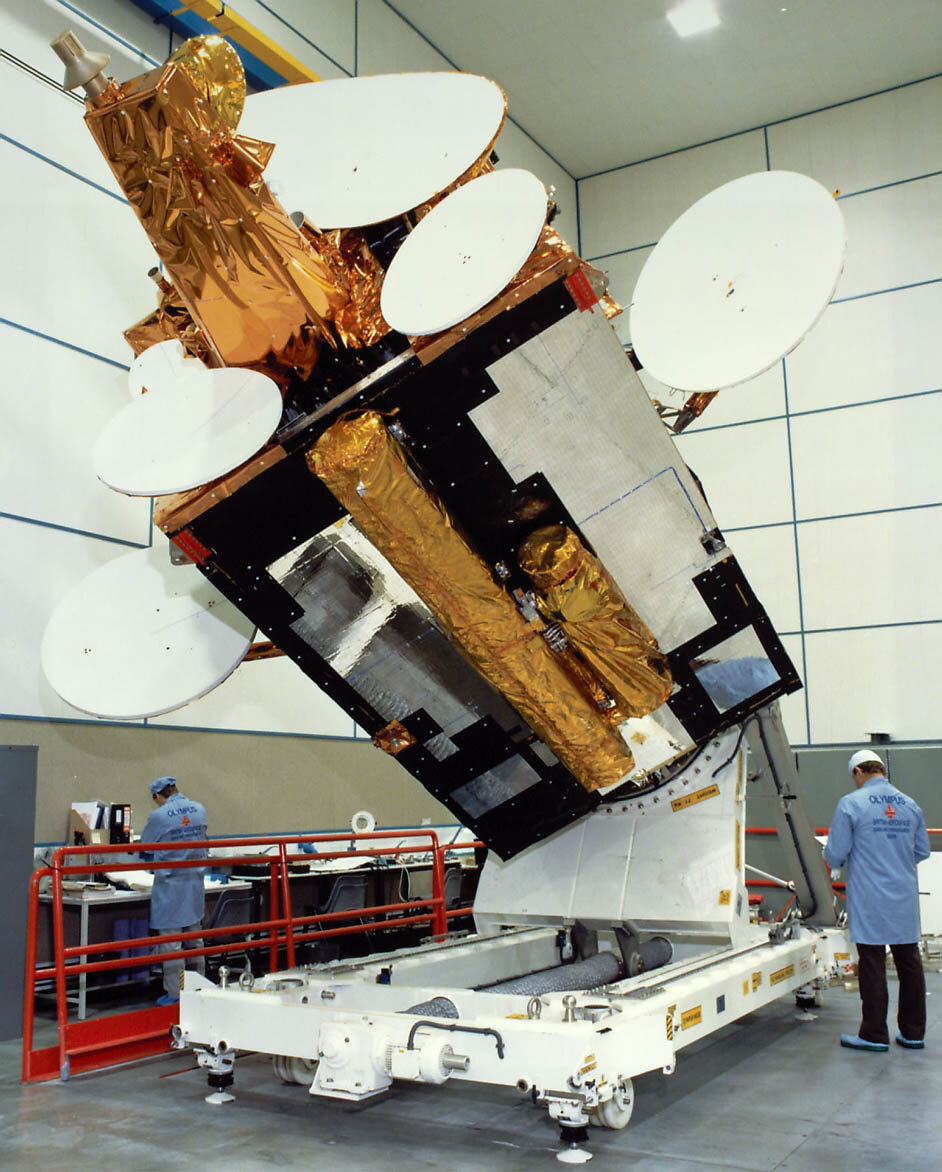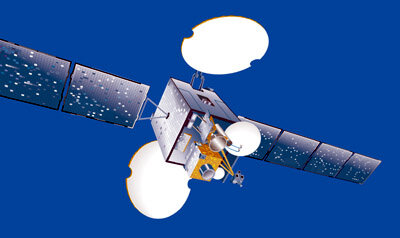About Telecommunications
Telecommunication satellites: what for?
Just a few years ago two of every three intercontinental telephone calls were transmitted by telecommunication satellites. Satellites have proved particularly useful for communicating with many of the countries in the less developed parts of the world.
Today, new technology and different kinds of demand have changed the way communications satellites are used. More powerful satellites and the use of higher frequencies have made it possible for many people to receive directly signals from the sky. At the beginning of the 21st century more than 70 million European homes watch TV programmes through direct reception or through cable distribution systems.
Without us realising it, satellite communications permeate our lives. Many everyday actions that we take for granted happen because telecommunication satellites are in orbit, 36 000 km over our heads - they are reliable and can be used in a plethora of ways.
- Did you know than when you listen to the radio most likely the signal that you receive has been distributed from the central studios by satellite?
- Did you know that many newspapers and magazines are produced centrally but printed locally? The content of the paper is sent to the printing plants using satellite links.
- Did you know that even when a news or sport event shown on the television takes place just a few kilometres away from the studios it has probably been transmitted via satellite?
- Did you know that most news agencies use satellites to distribute text, audio or video to their affiliates?
- In many countries access to the internet is by satellite communication. This is not to say that satellite communications are the origin of the long waiting times that we sometimes experience, since the delay they introduce is never more than a quarter of a second (the time the radio signal takes to reach the satellite and come down again at the speed of light).
-
There are many other ways in which satellites are used, some very specific such as communicating between the national lottery networks in the UK and Spain, retail chains or banks in many parts of the world, remote post offices in little villages or for the control of water, gas or oil pipelines.
Increasingly satellites are being used for tele-education, tele-medicine or video conference systems. Plus, in most remote and not-so-remote parts of the world, satellite communications continue to play a fundamental role in the structure of telephone and other services. - The Inmarsat mobile satellite communications system has also changed the way in which mariners communicate with the rest of the world. Satellite systems for mobile communications are now an indispensable component of the global telecommunication infrastructure. In addition to Inmarsat other mobile satellite systems, regional and global, have been conceived to complement and to satisfy our demand to be connected anytime and in anyplace.
There are many types of telecommunication satellites and they vary in design according to their purpose. They use different orbits, different frequencies and they transmit very different type of signals using a variety of power levels.
Orbits
A fundamental principle behind telecommunication satellites is the type of orbit they use. TA geostationary orbit was first proposed by the British science and science fiction writer Arthur C.Clarke. To understand it better we have to remember some basic physics:
If you throw an object with a speed of more than 10 km/sec towards the sky in the right direction you have an artificial satellite. This means the satellite will keep turning around the Earth without falling. The centrifugal force of the satellite is compensated by the attraction of the Earth. It will not need any propellant and will continue to orbit the Earth, although eventually friction with the upper layers of the atmosphere will bring it down.
Low Earth orbit satellites, such as the Space Shuttle, the International Space Station and many other scientific and Earth observation satellites have very high relative angular motion with respect to the Earth. In fact, they orbit the Earth in around 90 minutes at heights of just a few hundred kilometres. The distance from London to Paris does not seem very much when we compare it with the diameter of the globe.
If a satellite is launched with more energy, (i.e. more speed) it will go further and faster. However, the radius of the orbit will also be larger and the net result is that the angular motion is comparatively slower.
A telecommunication satellite in low Earth orbit will appear in the west and move towards the east, being visible for about 10 minutes at a time. This is fine if you only want to communicate for just a few minutes, but not very good if you want the satellite to beam to Earth a TV programme or a football match. Also your antenna would have to track the satellite to maintain contact.
Geostationary orbit is tremendously useful for telecommunications. It is in the same plane as the equator and at such a distance that satellites complete an orbit every 24 hours. This means that they orbit the Earth at the same angular speed at which the Earth is turning. Therefore, to the observer the satellite appears to be stationary and an antenna pointed at a geostationary satellite will remain pointed to the satellite year after year without any need to touch it.
The use of satellites in geostationary orbit allows permanent links to be established by just transmitting a radio-frequency signal (not very different for instance from the signals that are used to broadcast terrestrial television, i.e. UHF, but usually of a frequency 3 to 50 times greater). The signal is received, amplified and transmitted back to the Earth allowing communications between points that are thousands of kilometres away.
A particular property that makes geostationary satellites extremely attractive is their capacity to broadcast. Indeed, the signal that is transmitted by the satellite can be picked up by antennas anywhere in the coverage area of the satellite. This can be an area the size of a country, a region, a continent or the face of the Earth that the satellite can see. But the most important effect is that anyone with a relatively small antenna (some times as small as 40 or 50 cm in diameter), can become a direct user of the satellite.
In the last decade other system concepts have been developed around the use of constellations of low Earth orbiting satellites. These systems guarantee the continuity of their services by ensuring the constant availability of at least one satellite (in most cases two, three or even four satellites) over the users line of sight.
LEO systems, as they are generically called, require 48,66, 77, 80 or even 288 satellites to cover the whole planet and provide the required services. Several of these systems are designed to provide communications to mobile terminals. They use a relatively low frequency, and the fact that the user's antennas are not very selective is a plus for them: no careful tracking of the satellite is then needed. Also, the low altitude decreases the delay and the power needed to establish communications.
The market for satellite communications has been expanding at a sustained rate of more than 15% a year. When launchers, user terminals and specially derived services are taken into account this market, currently around €90 billion, is expected to grow to around €220 billion in the next 7-8 years. Satellite communications and launchers have been by far the most important application of the space programme both in Europe and other countries.
European industry and European telecommunication operators are at the forefront of this huge international market thanks in part to the vision of ESA and the effort the Agency and its Member States have put into developing new technology and satellite systems over the past three decades.
ESA mission

ESA's mission in this fast-moving area is to help make European industry and operators competitive on the world stage by supporting technological R&D and pioneering developments necessary for bringing new technologies near to market readiness, and helping to forge partnerships capable of creating wealth, jobs and new services for the citizens of Europe.
By investing in new technological avenues and new system concepts, ESA acts as a catalyst for European industry to develop and exploit emerging products, services and markets. In addition, ESA provides a framework and meeting point which facilitates the discussion, and the harmonization and generation of standards.
Historical perspective

Together with rocket launchers, communications satellites represent by far the largest commercial space market worldwide. Our planet is girded with a belt of over 100 satellites for radio, television and telephone communications. In 30 years, they have revolutionised society, changed the way our economies work and introduced new dimensions to television and entertainment.
ESA started to develop communications satellites in 1968 and launched an Orbital Test Satellite (OTS) 10 years later. The OTS satellite was used for more then 13 years by ESA and Eutelsat (Europe's organisation for satellite telecommunications) and by European national telecommunications companies to demonstrate new services, such as broadcasting to cable feeds and direct-to-home television. Its design inspired the conception of many subsequent satellites in Europe.
Following this pioneering work ESA developed and launched four European Communications Satellites (ECS) between 1983 and 1988 for use by Eutelsat. Each ECS allowed coverage of the whole European continent for cable television, telephone communications, specialised services and Eurovision transmissions. Two of those satellites are still in commercial service.
For communications with mobile stations, especially ships at sea, ESA developed two MARECS satellites. Launched in 1981 and 1984, they were later leased for operations to Inmarsat, the international maritime satellite organisation. Their L-band payloads, with global coverage, could handle just around 50 telephone circuits. One is still in service today.
A giant orbiting test bed

ESA's Olympus experimental satellite was the largest civilian telecommunications satellite in the world at the time of its launch in 1989. Its design incorporated many key technologies and its direct-to-home TV broadcasting payload allowed national network programmes to be captured with antenna dishes as small as 30 cm in diameter.
Olympus also provided regular High Definition Television (HDTV) transmissions and capacity for digital broadcasting experiments. Small terminals, with antennas of up to 2.5 m, used a Specialised Business Services payload for two-way communications, exchanging data, images and video signals, or for broadcasting to a selected number of viewers (known as narrowcasting).
Control of Olympus was accidentally lost in May 1991 but a major recovery action enabled it to resume full service by the following August. Two years later the ambitious experimental mission ended when the spacecraft's fuel ran out.
The future

In 2001 a new telecommunications satellite, called Artemis, was launched to continue the technological development of Europe’s space infrastructure.
With an eye on the more distant future, ESA is also pursuing a programme called ARTES (Advanced Research on Telecommunication Satellites) that is looking at innovative ways of developing and using communications technology.
This is ESA's seed bed for developments that will become part of our everyday lives as the first decade of the 21st century moves into the second.




